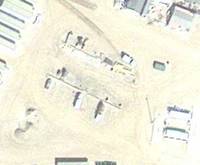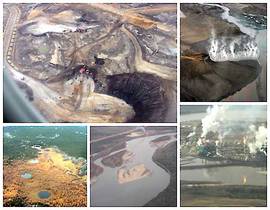Vast volumes of gas and oil still exist in parts of the world, but at low concentrations and mixed in with rocks such as sand and shale, which make it difficult, expensive and polluting to mine.
Most oil mined over the past 100 years has been conventional crude oil. Thicker than cooking oil, but more fluid than runny honey, crucially, it will flow along pipes making it transportable. Most of what's left is in middle eastern countries. But there are large reserves of unmined unconventional oil that exists as Tar Sands deposits, in Canada and the USA, and as heavy Oil Sands in Venezuela.
Canada's deposits could make it the second largest source of oil after Saudi Arabia source

Tar Sands
Tar sands is basically a type of oil called Bitumen, mixed with sand. Bitumen is semi-solid or at best the consistency of set honey.
Extracting it is expensive
Tar sands are sometimes found at the surface, such as in Alberta, Canada, where large areas of forest have been cut down to expose the ore benieth. Vast volumes of sand is scraped up and steam used to melt the oil out of it, leaving huge ponds of contaminated water. This water can contain chemicals from both the injected water and those washed out from the rocks including known cancer causing substances. Deposits deeper down can only be accessed by injecting high pressure steam underground.
Transporting it is difficult - Dilbit (dliuted bitumen)
Because Bitumen is so thick and sticky, it cannot be moved through a conventional pipeline in its raw form. It will only flow well enough if heated and diluted using natural gas as a solvent. This diluted form is known as Dilblt (diluted bitumen), which is highly corrosive as well as toxic.

Ethical issues
Ecosystem damage
To mine tar sands, the surface has to be stripped back to the bare earth and then dug up. Huge areas of ancient forests in Canada are being cleared, permanently destroying unique habitats for wildlife that cannot be replaced.
Pollution
Dilbit (diluted bitumen) oil can only flow along pipes under high pressure and is highly corrosive. Moving such a material long distances at high pressure through steel pipelines creates a risk of leaks and spills. If there is a spill, Dilbit is extremely difficult to clean up from the environment. Unike conventional oil, which floats on water and be skimmed off, Dilbit becomes glue-like when exposed to air, doesn't float and so sticks to the bottom of any water course it enters.
At the mine, polluted water can leak out of the holding ponds if they are not properly managed.
Greater CO2 output and climate change
Extracting usable oil from tar sands takes a great deal of energy. Heavy machinery has to dig up vast volumes of sand. Water has to be boiled to make the steam to extract the oil and then additional energy is needed to push a thick liquid along pipelines. When you add together the carbon output of burning the oil together with the carbon used to generate the energy needed to get hold of it, tar sands oil results in 15-50% more CO2 output than conventional oil. source

In pictures -  National Geographic report
National Geographic report

This moving TED talk discusses the effects of the Alberta Tar Sands mining on the Canadian Boreal Forests, on the local Canadian indigenous peoples and its potential big effect on climate change.
Or this shorter film from The Cooperative

 Get a sense of the scale of tar sands mines.
Get a sense of the scale of tar sands mines.
 Look at this image on Google Maps. It is a car park at a tar sands mine in Alberta, Canada. Notice the size of the trucks there. This will give you a sense of scale for the picture.
Look at this image on Google Maps. It is a car park at a tar sands mine in Alberta, Canada. Notice the size of the trucks there. This will give you a sense of scale for the picture.
Now click on the Minus Icon at the bottom of the slider on the left and zoom out one click at a time, to see just how big tar sands mines can be. This one in Fort McMurray is nearly 20 miles long by 5 miles wide.

Shale Oil
"Oil Shale" is basically oil that comes from any kind of sedimentary rock where, when the rock ore is heated, the oil melts and is released from the rock. The risk to the environment from mining pollution and increased CO2 output are broadly similar to those of Tar Sands.

 Fracking (hydraulic fracturing)
Fracking (hydraulic fracturing)

For teachers -  Sierra Club report on Tar sands.
Sierra Club report on Tar sands.


 Get a sense of the scale of tar sands mines.
Get a sense of the scale of tar sands mines.![]() Look at this image on Google Maps. It is a car park at a tar sands mine in Alberta, Canada. Notice the size of the trucks there. This will give you a sense of scale for the picture.
Look at this image on Google Maps. It is a car park at a tar sands mine in Alberta, Canada. Notice the size of the trucks there. This will give you a sense of scale for the picture.
![]() Fracking (hydraulic fracturing)
Fracking (hydraulic fracturing)![]() Sierra Club report on Tar sands.
Sierra Club report on Tar sands.


What's your opinion?
Average rating




Not yet rated